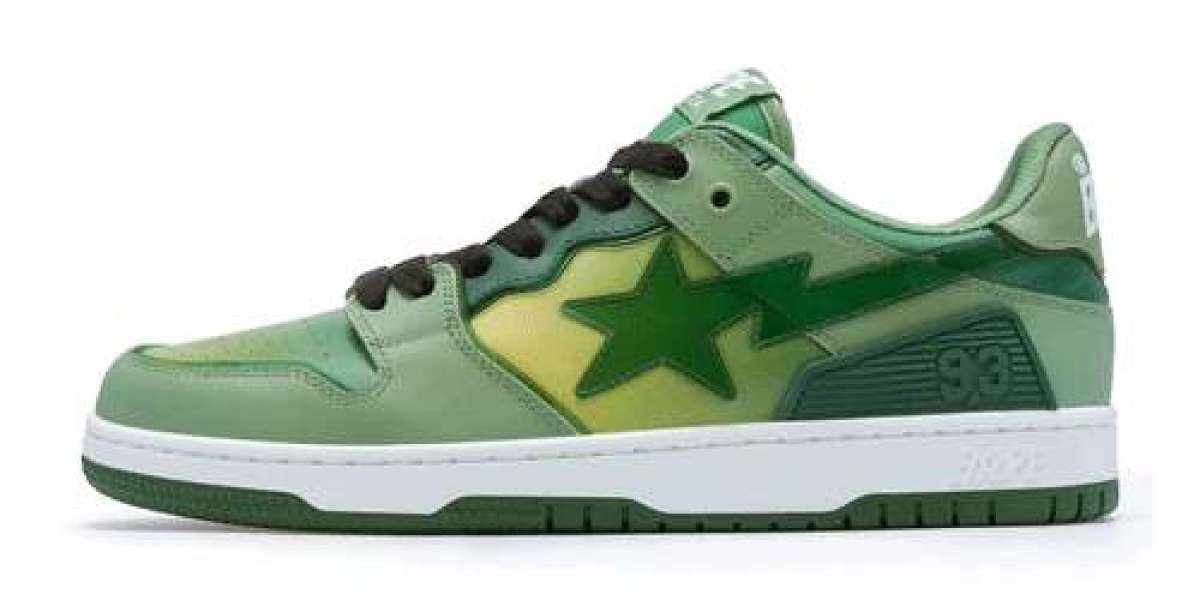When it comes to sneaker culture, few names carry the weight and mystique of the Bapesta. Created by Japanese streetwear powerhouse A Bathing Ape (BAPE), the Bapesta has transcended the label of just being a shoe. It’s a cultural icon, a collector’s grail, and a symbol of fashion rebellion. With its bold designs, unmistakable star logo, and deep roots in hip-hop and streetwear history, the Bapesta continues to stand tall in an ever-evolving sneaker landscape.
In this article, we explore how the Bapesta was born, its rise to fame, collaborations that made waves, and why it remains relevant in 2025.
Origins of the Bapesta: From Tokyo to the World
The Bapesta was first introduced in the early 2000s by Nigo, the founder of A Bathing Ape. At a time when Nike’s Air Force 1 dominated the sneaker world, Nigo saw an opportunity. Inspired by the AF1’s silhouette, he created a bold reinterpretation that reflected his own aesthetic: bright colors, glossy patent leather, and an instantly recognizable shooting star in place of the Swoosh.
Nigo’s goal wasn’t to copy but to remix. In Japanese fashion culture, remixing Western styles with local sensibilities is a well-established practice. The Bapesta wasn’t a knockoff—it was a love letter to street culture, filtered through a hyper-creative Japanese lens.
Released exclusively through BAPE stores in Japan, the sneaker quickly gained cult status, especially among those who craved something different from the mainstream sneaker drops.
The Cultural Impact: Co-signs from the Hip-Hop World
One of the most defining factors behind the Bapesta’s rise to global recognition was its strong association with hip-hop culture. In the early 2000s, rap icons like Pharrell Williams, Kanye West, and Lil Wayne were often seen rocking Bapestas. These weren’t just casual sightings; Bapesta became a visual symbol of luxury streetwear before that term even gained popularity.
Pharrell, in particular, played a massive role in bridging the gap between Tokyo streetwear and American hip-hop. As a close friend of Nigo, he wore Bapestas religiously, eventually collaborating with BAPE under his own Billionaire Boys Club label. Kanye West famously designed his own Bapesta, featuring artwork from his "College Dropout" album, making it one of the most iconic artist collaborations in sneaker history.
These moments gave the Bapesta not just credibility but cultural currency. Owning a pair meant being in the know, being ahead of the curve, and being bold enough to wear sneakers that turned heads.
Design Aesthetic: Loud, Glossy, and Unapologetic
The Bapesta’s design philosophy goes against the grain of minimalist sneaker trends. Its signature elements—shiny patent leather, candy-colored palettes, and the “STA” shooting star—are loud by design. It’s meant to be seen.
Unlike the muted tones of modern sneakers or the high-tech aesthetic of performance shoes, Bapestas celebrate maximalism. The upper is often composed of contrasting hues, with mismatched panels that scream individuality. Even the sole carries a unique design, often featuring embossed logos and eccentric color blocks.
Each drop is limited, often themed, and never shy. From camouflage prints to anime-inspired designs, the Bapesta doesn’t play it safe—and that’s exactly why it’s adored.
Evolution Through Collaborations
If there’s one thing that has kept the Bapesta fresh, it’s the sheer volume and diversity of collaborations. Over the years, BAPE has teamed up with brands and artists across fashion, entertainment, and art.
Collaborations with Marvel, Pepsi, DC Comics, and high-fashion houses like Coach have taken the Bapesta far beyond the sneaker world. One of the most notable recent collabs includes the Bape x JJJJound Bapesta, which marked a rare venture into minimalist design for the typically flamboyant sneaker.
By constantly reinventing its colorways and themes while maintaining the core silhouette, the Bapesta remains both familiar and fresh. It's a masterclass in how to evolve a brand without losing its DNA.
The Resale Market and Collectibility
Sneakerheads know that part of what defines a great sneaker is its scarcity and demand in the resale market. The Bapesta has consistently been a high-ticket item on platforms like StockX and GOAT, especially limited-edition drops and artist collaborations.
Collectors value Bapestas not just for their design but for what they represent—a slice of fashion history. Early 2000s pairs now fetch significant sums, and even newer releases hold their value well. While it might not always command the same resale premiums as Yeezys or Jordans, the Bapesta appeals to a niche, style-savvy crowd that prioritizes cultural depth over hype.
Bapesta in 2025: Still a Streetwear Power Move
Fast forward to today, and the Bapesta remains a cornerstone of the modern streetwear wardrobe. While trends have shifted and new brands have entered the game, BAPE has held its position as a heritage label that innovates just enough to stay current.
Recent releases have embraced modern fashion sensibilities, including sustainable materials, collaborations with up-and-coming artists, and regional exclusives that tap into local cultures. The Bapesta is no longer just for the elite sneakerhead—it’s for anyone who values the fusion of bold design and rich cultural history.
As streetwear becomes more global and inclusive, the Bapesta finds itself at a sweet spot: nostalgic for those who were there in the early days, yet exciting and aspirational for the new generation.
How to Style the Bapesta
Styling a Bapesta requires confidence. These aren’t shoes you throw on without thinking—they demand attention and deserve a considered outfit.
Pair them with wide-leg cargos, a relaxed graphic tee, and a statement cap for a Y2K-inspired fit. Or go for a more modern vibe with techwear elements, like zippered pants and layered jackets. They also work surprisingly well with elevated streetwear—think cropped blazers, premium denim, and designer accessories.
Ultimately, wearing Bapestas is about owning your look. They’re conversation starters, not background pieces.
Final Thoughts: Why Bapesta Still Matters
In a world of constant sneaker drops, algorithm-driven trends, and hype cycles that fade in weeks, the Bapesta stands out as something more than a shoe. It’s a cultural artifact, a fashion statement, and a symbol of rebellion against conformity. It represents a time when streetwear wasn’t mainstream, and wearing something like a Bapesta meant you were part of an underground movement.
Whether you're a seasoned collector or a newcomer to streetwear, understanding the Bapesta is essential. It teaches us that authenticity, creativity, and bold self-expression will always have a place in fashion—no matter how trends change.








